Y'all have a great summer. I missed seeing you off and I hope to see you again next year! ~Mrs. Orcutt 
May 11-May 17 2020
ASL Interpretation of the Lesson
This week we are going to look at Nuclear Power Plants
Increasingly, our country has become a nation of electricity users. We depend on an abundant affordable supply of energy to power the many machines we use in our complex society. Can you imagine what it would be like not having electricity in your home? About one-third of our energy resources are used to produce electricity.
In America, nuclear energy plants are the second-largest source of electricity after coal-producing approximately 20 percent of our electricity. The purpose of a nuclear power plant is to produce electricity.
While nuclear power plants have many similarities to other types of electricity-generating plants, there are some significant differences.
With the exception of solar, wind, and hydroelectric plants, all electricity-generating plants including nuclear convert water to steam that spins the propeller-like blades of a turbine that spins the shaft of a generator. Inside the generator coils of wire and magnetic fields interact to create electricity.
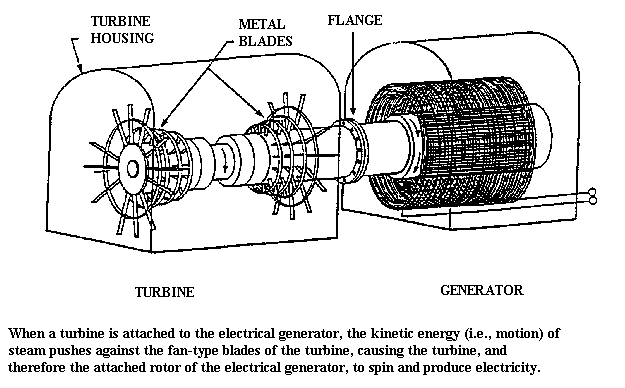
The energy needed to boil water into steam is produced in one of two ways: by burning coal, oil, or gas (fossil fuels) in a furnace or by splitting certain atoms of uranium in a nuclear energy plant. Nothing is burned or exploded in a nuclear energy plant. Rather, the uranium fuel generates heat through a process called fission.
WHAT IS FISSION? WHERE DOES IT TAKE PLACE?
Uranium is an element that can be found in the crust of the Earth. This element, quite abundant in many areas of the world, is naturally radioactive. Certain isotopes of uranium can be used as fuel in a nuclear power plant. The uranium is formed into ceramic pellets about the size of the end of your finger.
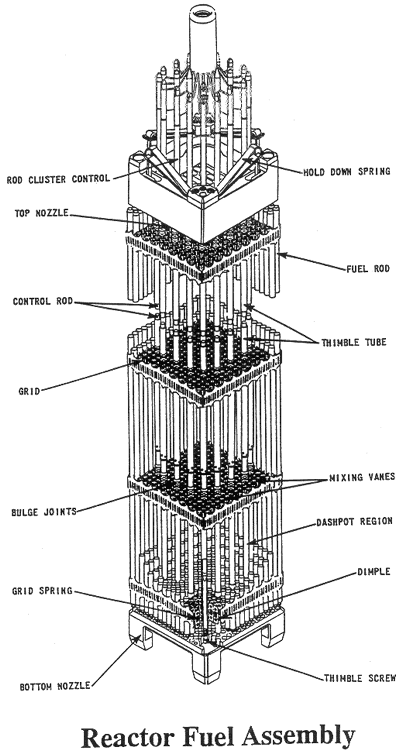
These pellets are inserted into long, vertical tubes (fuel rods) within the reactor. The reactor is the heart of the nuclear power plant. Basically, it is a machine that heats water.
A reactor has four main parts: the uranium fuel assemblies, the control rods, the coolant/moderator, and the pressure vessel. The fuel assemblies, control rods, and coolant/moderator make up what is known as the reactor core. The core is surrounded by the pressure vessel.
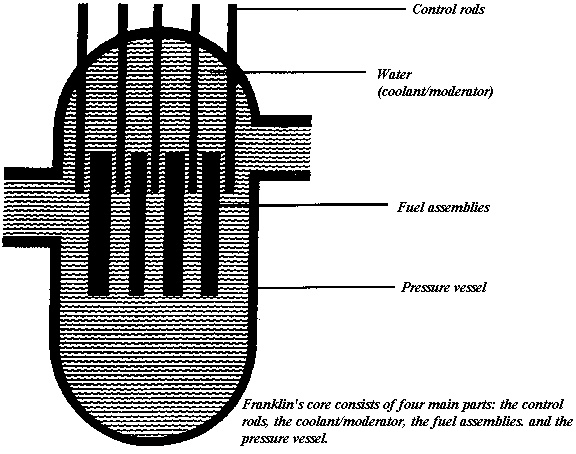
We also have to understand that uranium cannot just be thrown into a reactor the way we shovel coal into a furnace. The fuel rods, containing the uranium, are carefully bound together into fuel assemblies, each of which contains about 240 rods. The assemblies hold the rods apart so that when they are submerged into the reactor core, water can flow between them.
When the uranium atom splits, it releases energy and two or more neutrons from its nucleus. These neutrons can then hit the nuclei of other uranium atoms causing them to fission. The sequence of one fission triggering others, and those triggering still more, is called a chain reaction.
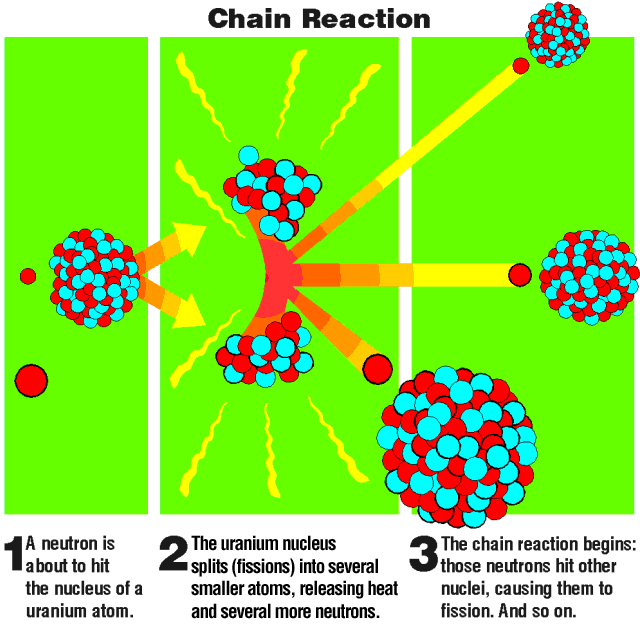
When the atoms split, they release energy in the form of heat. The heat is transferred from the reactor core to the water flowing past. That water becomes high-pressure steam which turns the turbine in the electric generator.
The basic design of the nuclear fuel steam plant and its various components.
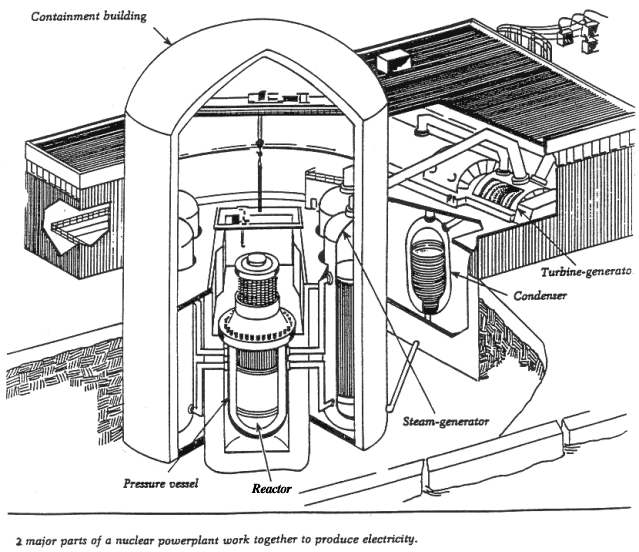
The control rods slide up and down in between the fuel assemblies in the reactor core. They control or regulate the speed of the nuclear reaction by absorbing neutrons. Here's how it works: When the control rods absorb neutrons, fewer neutrons hit the uranium atoms thus slowing down the chain reaction.
On the other hand, when the core temperature goes down, the control rods are slowly lifted out of the core, and fewer neutrons are absorbed. Therefore, more neutrons are available to cause fission. This releases more heat energy.
Just as there are different types of houses and cars, there are different types of nuclear power plants that generate electricity. The two basic types being used in the United States are the boiling water reactor (BWR) and the pressurized water reactor (PWR). These power plants are often referred to as light water reactors.
BOILING WATER REACTOR (BWR)
The boiling water reactor operates in essentially the same way as a fossil fuel generating plant. Neither of these types of power plants have a steam generator. Instead, water in the BWR boils inside the pressure vessel and the steam water mixture is produced when very pure water (reactor coolant) moves upward through the core absorbing heat. The water boils and produces steam. When the steam rises to the top of the pressure vessel, water droplets are removed, the steam is sent to the turbine generator to turn the turbine.
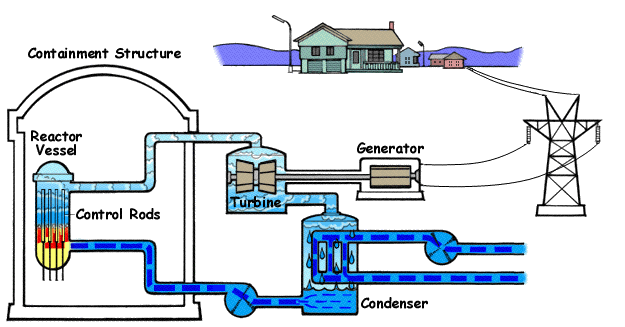
PRESSURIZED WATER REACTOR (PWR)
The pressurized water reactor differs from the BWR in that the steam to run the turbine is produced in a steam generator. Water boils at 212°F or 100°C. If a lid is tightly placed over a pot of boiling water (a pressure cooker), the pressure inside the pot will increase because the steam cannot escape. As the pressure increases, so does the temperature of the water in the pot. In the PWR plant, a pressurizer unit keeps the water that is flowing through the reactor vessel under very high pressure to prevent it from boiling. The hot water then flows into the steam generator where it is converted to steam. The steam passes through the turbine which produces electricity. About two-thirds of the reactor power plants in the U.S. are of the PWR type.

Our nearest Nuclear Reactor Plant is the Comanche Peak Nuclear Power Plant in Glen Rose, Texas. Click on the link to find out information about the Plant.
--> Assignment to turn in by email to Orcutt For worksheet click here Turn this in (picture, scan, copy/paste on document, however you can get it to me) to sharon.orcutt@wacoisd.org
When you are running a long competition race, you sprint the last 50 yards. Folks, THIS is our last 50 yards!!! You can make your grades look fabulous for this semester with just a little effort these last few weeks!
May 3-May 10 2020
I have had numerous students ask me for some extra time on the assignments for the last 2 weeks. I will extend the time to May 10 (Mother's Day) with the advice to watch the edpuzzles first because they explain the particles very well.
.jpg)
April 27-May 3 2020
This week's assignment will be a continuation of what you began last week. The assignment is at the end of this post. First though, I want to talk to you about how to deal with classes and your time. Up to now, you have had assigned times to do each of our classes. Now you have 24 hours to figure it out by yourself. Getting stuff done is hard, especially things that you do not want to do and that you usually put off. There always seems to be something else to do such as leveling up on a game, a phone call to your friend.
Enter: the Pomodoro Technique. This popular time-management method can help you power through distractions, hyper-focus, and get things done in short bursts while taking frequent breaks to come up for air and relax. Best of all, it is easy.
The methodology is simple: When faced with any large task or series of tasks, break the work down into short, timed intervals (called “Pomodoros”) that are spaced out by short breaks. This trains your brain to focus for short periods and helps you stay on top of deadlines. With time it can even help improve your attention span and concentration.
Pomodoro is a cyclical system. You work in short sprints, which makes sure you are consistently productive. You also get to take regular breaks that bolster your motivation and keep you creative.
How the Pomodoro Technique works
The Pomodoro Technique is probably one of the simplest productivity methods to implement. Here is how to get started with Pomodoro, in five steps:
- Choose a task to be accomplished.
- Set the Pomodoro to 25 minutes (the Pomodoro is the timer)
- Work on the task until the Pomodoro rings, then put a check on your sheet of paper
- Take a short break (5 minutes is OK)
- Every 4 Pomodoros take a longer break
That “longer break” is usually on the order of 15-30 minutes, whatever it takes to make you feel recharged and ready to start another 25-minute work session. Repeat that process a few times over the course of your workday, and you actually get a lot accomplished—and took plenty of breaks to grab a cup of coffee or refill your water bottle in the process.
It’s important to note that a Pomodoro is an indivisible unit of work—that means if you’re distracted part-way by a friend or family member, meeting, or emergency, you either have to end the Pomodoro there (saving your work and starting a new one later), or you have to postpone the distraction until the Pomodoro is complete.
Try the “inform, negotiate, and call back” strategy:
- Inform the other (distracting) party that you are working on something right now.
- Negotiate a time when you can get back to them about the distracting issue in a timely manner. Eg. “I’m in the middle of something right now, but can I get back to you in....ten minutes?”
- Schedule that follow-up immediately.
- Call back the other party when your Pomodoro is complete, and you are ready to tackle their issue.
.
Since a timer is the only essential Pomodoro tool, you can get started with any phone with a timer app, a countdown clock, or even a plain old egg timer. Here are a few to consider:
- Marinara Timer (Web) is a web app that you can keep open in a pinned tab. You can select your timer alerts, so you know when to take a break, or reconfigure the work times and break times to suit you.
- Tomighty (Win/Mac/Linux) is a cross-platform desktop Pomodoro timer that you can fire and forget, following the traditional Pomodoro rules, or use to customize your own work and break periods.
- Eggcellent is a combination Pomodoro timer and to-do app. It offers more visual cues when your tasks are complete and what you have coming up next, and it integrates nicely with OS X’s Reminders app. Plus, you can estimate how many Pomodoros you’ll need to complete a task, and then track your progress.
- Focus Timer (iOS) is a feature-rich timer for iPhone and iPad. I use this one but it is a paid app (there are others that are free, but I just have not tried them yet). You can customize work and break durations, review your work history to see how your focus is improving, easily see how much time is left in your work session, and the app even offers a star-based rating system to keep you motivated. You can even customize the sounds and hear the clock ticking when you lock your phone, so you stay on task.
- You can also use Google as a timer. Remember, the focus of the Pomodoro Technique is on the work, not the timer you use.
Finally, it is important to remember that Pomodoro is a productivity system—not a set of shackles. If you are making headway and the timer goes off, it is OK to pause the timer, finish what you are doing and then take a break. The goal is to help you get into the zone and focus—but it is also to remind you to come up for air. Regular breaks are important for your productivity.
--> Your Assignment for this week:
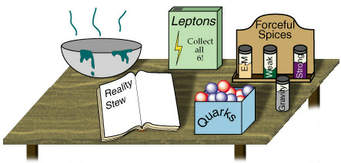
Lesson-Go back to the Particle Adventure Website below and do the two assignments. This is a continuation of the work we started last week and therefore is using the same website.
There is both an iPhone app and an Android app for this site.
You will be doing two assignments that you can access and download Activity 2 Leptons and Activity 3 Accelerators
The website for this particular activity is located here.
You may email the answers to me as a scanned document, word document, shared Google document, or just put the answers in the email
Mrs. Orcutt sharon.orcutt@wacoisd.org
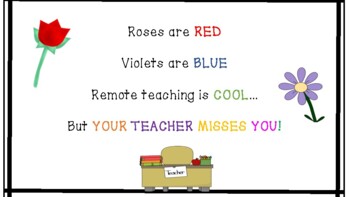
April 20-26 2020
ASL Interpretation of the lesson
For the next couple of weeks, we are going to enter the weird world of the very small fundamental particles and forces.
The theories and discoveries of thousands of physicists since the 1930s have resulted in a remarkable insight into the fundamental structure of matter: everything in the universe is found to be made from a few basic building blocks called fundamental particles, governed by four fundamental forces. Our best understanding of how these particles and three of the forces are related to each other is encapsulated in the Standard Model of particle physics. Developed in the early 1970s, it has successfully explained almost all experimental results and precisely predicted a wide variety of phenomena. Over time and through many experiments, the Standard Model has become established as a well-tested physics theory. The Standard Model is currently the best description there is of the subatomic world, but it does not yet explain the complete picture. The theory incorporates only three out of the four fundamental forces, omitting gravity. There are also important questions that it does not answer, such as “What is dark matter?”, or “What happened to the antimatter after the big bang?”, “Why are there three generations of quarks and leptons with such a different mass scale?” and more. So there is still a lot of research that needs to be done in this field.

Lesson-Log in to Edpuzzle and watch these two assigned videos and answer the questions as an introduction:
The Standard Model of Particle Physics-Elemental Particles
IB Physics: Exchange Particles
If you cannot remember your log in or your password, email or call my Google Voice #.
If you have an iPhone there is an app called The Particle Zoo that will give you the information for each of the particles in the Standard Model.
Lesson-Go to the Particle Adventure Website below and do the introductory assignment about the basics of what is fundamental.
There is both an iPhone app and an Android app for this site.
You will be doing an introduction assignment that you can access and download here.
The website for this particular activity is located here.
You may email the answers to me as a scanned document, word document, shared Google document, or just put the answers in the email.
For Fun-Quarkdance (enable Flash to see)
If you need me to talk to you directly, we can do a video chat. As always, I am just an email away and you are welcome to converse with me, ask questions, or tell me what you may need. I will do my best to help you out.
Still miss you so much,
Mrs. Orcutt
April 13-19 2020
ASL Interpretation of the lesson
Thank you for all of the nice emails and effort on work turned in last week from so many of you. If you still need some time to work on last week's assignments, I have extended the time for you.
This week we are going to work on our scientific methodology skills. Then we will look at the world of quantum and particle physics.
For this assignment, we are going to look at information surrounding the COVID19 pandemic and make a short 10 slide presentation about it using words and current memes. This will be something that you should save as a memory as well as turn in to me. The link to the assignment and the rubric are here for you to download. You may do this in Google slides, PowerPoint, Hyperdocs, or any other platform that you choose and email the finished product to me sharon.orcutt@wacoisd.org.
Some websites to help get you going:
Separating myth from fact around coronavirus – HudsonAlpha Institute for Biotechnology
Coronavirus Disease 2019 (COVID19) - Texas Department of Health and Human Services
https://www.cdc.gov/coronavirus/2019-ncov/daily-life-coping/share-facts.html
Understanding the Novel Coronavirus - GoInvo
If you want to make your presentation into a 3-minute video, here is a link for a $250,000 scholarship that you could enter
And again, if you know a senior or happen to be a senior please pass this on to them Seniors Can Participate in Minecraft Graduation Ceremony. High School seniors can sign up here.
Miss you bunches,
Mrs. Orcutt
April 6-12 2020
ASL Interpretation of the Lesson Video 1 Video 2
Key Content Vocabulary:
- Ampere (amp) – unit of measurement for electric current
- Circuit – a closed conducting circle or loop through which current can flow
- Conductor – a substance or object that allows electricity to flow through it with low resistance
- Current – the flow of electrons through a conductor
- Electromagnet – an iron or steel core that is magnetized by electric current in a coil that surrounds it
- Insulator – a substance or object that does not conduct electricity
- Ohm – unit of electrical resistance
- Ohm’s law – an equation that describes the relationship between current, voltage, and resistance in an electrical circuit; I=V/R
- Parallel circuit – an electrical circuit in which electric current has multiple paths through which it can flow
- Resistance – measure of how much a material opposes the flow of electric current; measured in ohms; R=V/I
- Resistor – a material or object that is designed offer a desired amount of resistance to the flow of electrical current
- Schematic – a diagram of an electrical circuit
- Series circuit – an electrical circuit in which electric current has only one path through which it can flow
- Volt – unit of measure for the difference of potential that would drive one ampere of current against one ohm of resistance
- Voltage – potential difference between positively-charged and negatively charged terminals of a battery, or between any two given points in a circuit; measured in volts; V=IR
Static Electricity Lesson-for the week of April 6, 2020
Literacy-Read the following resource and run the quick simulations for clarity. It is partially a review of what we were working on before Spring Break. You should be able to breeze through it and slow down on the sections that you don’t remember well.
You should focus though on the electrical charge, electrostatic field, and the eddy current testing section.
Electricity lesson from the Nondestructive Testing Resource Center
"Static" and "current" are not really two separate kinds of electricity. There is only one type of electrical energy. We usually call it Electromagnetism. It's true that electromagnetism has a wide variety of behaviors. Its behavior depends on the strengths of the electric field and the magnetic field involved. An electric field corresponds to voltage, and the magnetic field corresponds to current. The "map" below is intended to show us that "static electricity" and "current electricity" are really just two fields of science. But electromagnetism itself is a seamless whole, and the boundaries between its various parts exist only in our minds.
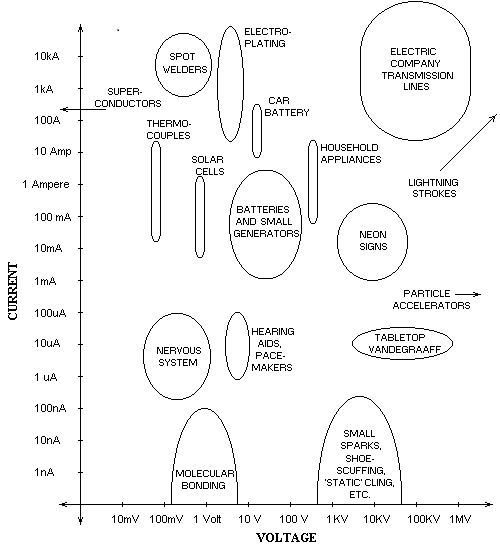
I know that picture is hard to see, but it demonstrates that static and current is a continuum and not two distinct types of electricity
STATIC ELECTRICITY:
Electrical happenings that involve HIGH VOLTAGE at low current.
CURRENT ELECTRICITY:
Electrical happenings that involve HIGH CURRENT at low voltage.
Some possible misconceptions you may have that need to be thought of differently:
- "Electricity" doesn't flow inside metal wires, charges do.
- Electrical science isn't based on electrons, it's based on charges. Yes, in metal wire it's mobile electrons, but in battery-acid its mobile protons, and in dirt and in human flesh it's mobile sodium and chloride. To avoid getting into the details, just call them "charges," positive and negative.
- Generators don't produce "electricity", they produce the electric pumping force. They also send out "electrical energy" which is made of invisible fields resembling radio waves that whiz along outside of the wires. Generators are charge pumps. They force the charges found inside the wires to flow along.
- Batteries don't supply "electricity", the wires do. A battery is a chemically-fueled charge pump. Like any other pump, a battery takes charges in through one connection and spits them out through the other. A battery is not a source of the "stuff" being pumped. When a battery runs down, it's because its chemical fuel is exhausted, not because any charges have been lost. (Remember that a battery is just a Fuel Cell, but it keeps its chemical fuel on board.) When you "recharge" a battery, you are forcing charges through it backward, which reverses the chemical reactions and converts the waste products back again into chemical fuel.
- Light bulbs don't consume "electricity." Instead, the charges of the thin filament all flow along much faster than they would in thicker wires, and this heats the filament because of a sort of "electrical friction". Charges are forced into the bulb through one terminal, but then they all flow back out again through the other terminal. The quantity of charges inside the filament doesn't change, and none are used up.
Lesson-Log in to Edpuzzle and watch these two assigned videos and answer the questions:
Bill Nye the Science Guy S2E5 Static Electricity
Awesome Science Tricks Using Static Electricity!
If you cannot remember your log in or your password, email or call my Google Voice #.
Lab-Go to the pHet lab John Travoltage and run the simulation
Complete the lab write-up (click for the document) and either email it or take a picture of it and send it to Orcutt-make sure your name is on it.
If you have any questions or comments (or you just want to say 'hi') send me an email and I will respond.
If you know a senior or happen to be a senior please pass this on to them Seniors Can Participate in Minecraft Graduation Ceremony. High School seniors can sign up here.
I miss you guys.
Mrs. Orcutt
Google Voice #254-340-4309